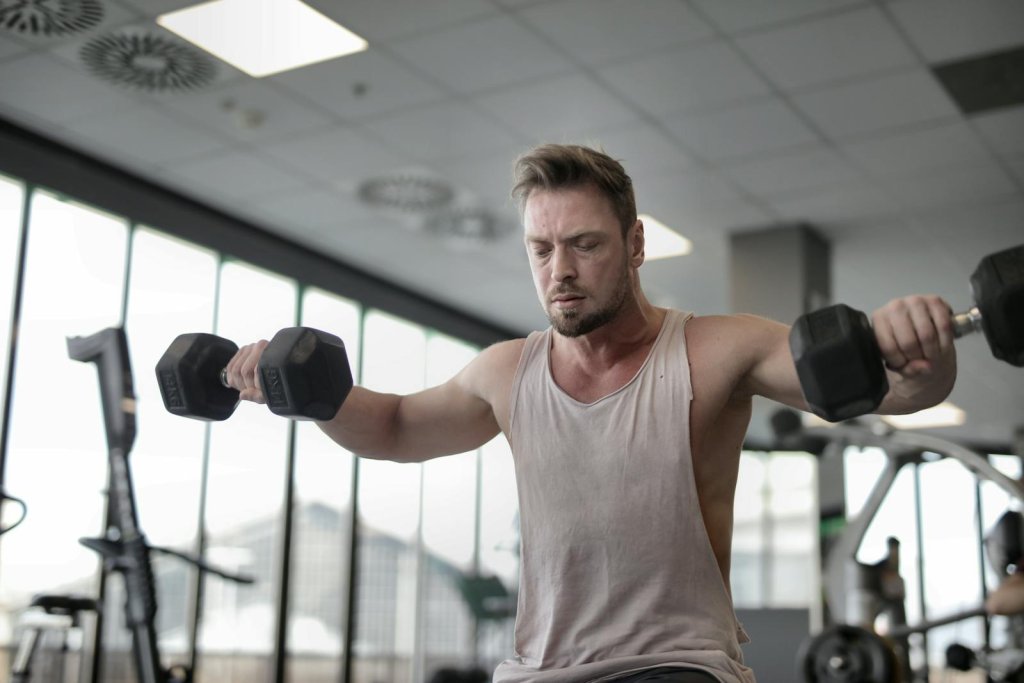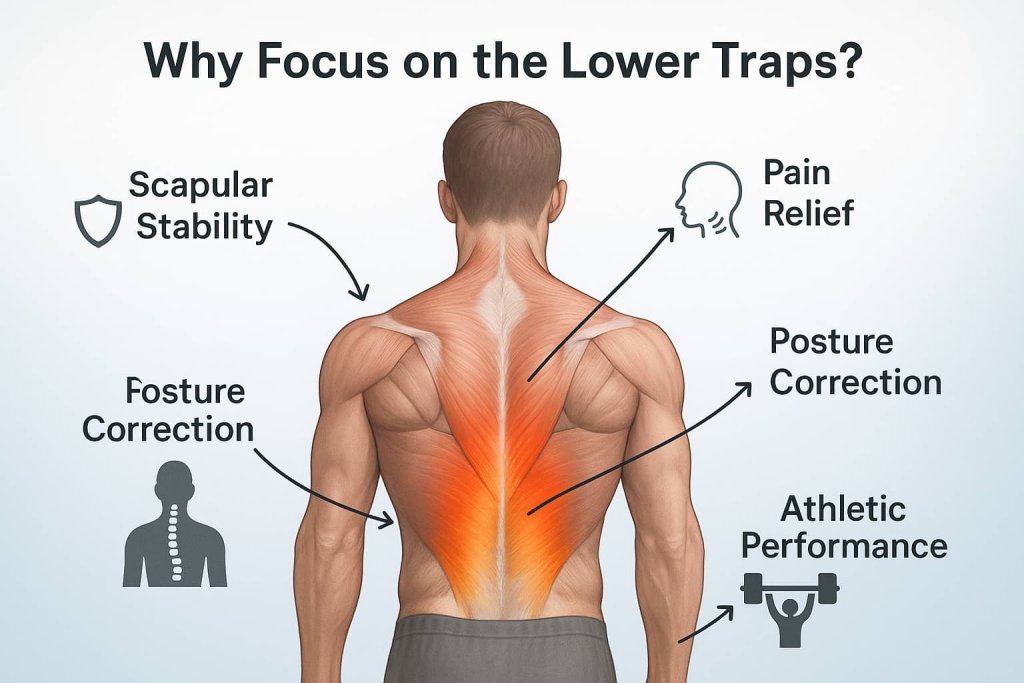Yes — strengthening your lower traps is one of the most effective ways to fix posture and reduce neck or shoulder pain. The lower trapezius plays a key role in stabilizing your shoulder blades, supporting overhead motion, and preventing rounded shoulders.

When the lower traps are weak, you’re more likely to experience forward head posture, shoulder impingement, and chronic upper-back tension. By adding lower trap exercises to your routine, you can improve posture, reduce pain, and boost shoulder stability. In this guide, we’ll cover 12 proven lower trap exercises with step-by-step instructions, benefits, and trainer tips — so you can start correcting posture today.
Why Focus on the Lower Traps?
The trapezius muscle has three parts — upper, middle, and lower. While most people overuse their upper traps, the lower traps often remain underdeveloped, leading to muscular imbalances. Strengthening them:

- Aligns the shoulder blades properly (scapular stability).
- Reduces neck and upper-back pain (NIH, 2020).
- Corrects rounded shoulders and slouched posture (Verywell Health, 2024).
- Improves overhead lifts and athletic performance.
12 Best Lower Trap Exercises
The lower trapezius is one of the most undertrained yet crucial muscles for shoulder health, posture, and pain prevention. Weak lower traps often lead to rounded shoulders, neck tightness, and reduced overhead mobility. These 12 exercises will help you build strength, stability, and balance across your upper back.
1. Standing Y Raise
How to do it:
- Stand tall holding light dumbbells or resistance bands.
- Start with arms down by your sides.
- With a slight bend in your elbows, raise your arms overhead into a “Y” shape.
- Keep shoulders down and avoid shrugging.
- Slowly return to the starting position.
Muscles worked: Lower traps, rhomboids, serratus anterior.
Why it works: Teaches scapular upward rotation—key for healthy overhead lifting.
Trainer Tip: Use a mirror to check that your ribs don’t flare out. Keep your core engaged for stability.
2. Scapular Squeeze
How to do it:
- Sit or stand tall with arms at your sides.
- Pinch shoulder blades together, squeezing them down and back.
- Hold for 3–5 seconds, then release.
- Repeat for 10–15 reps.
Muscles worked: Lower and middle traps.
Why it works: A simple, equipment-free drill to activate the traps. Perfect for desk workers.
Trainer Tip: Imagine tucking your shoulder blades into your back pockets.
3. Bent-Over T Raise
How to do it:
- Hold light dumbbells.
- Hinge at your hips until your torso is nearly parallel to the floor.
- Let arms hang straight down, palms facing each other.
- Lift arms out to the sides until they form a “T.”
- Lower with control.
Muscles worked: Lower traps, rhomboids, rear delts.
Why it works: Strengthens scapular retraction for better posture.
Trainer Tip: Avoid using momentum. Slow, strict reps give the best activation.
4. Resistance Band Rows
How to do it:
- Anchor a band at chest height.
- Grab the handles with palms facing each other.
- Row back by pulling elbows toward your sides.
- Focus on squeezing shoulder blades down and back.
Muscles worked: Lats, lower traps, rhomboids.
Why it works: Builds pulling strength while reinforcing scapular stability.
Trainer Tip: Don’t flare elbows too high—keep them close to your body.
5. Side-Lying Arm Rotation
How to do it:
- Lie on your side with a towel between your elbow and torso.
- Bend elbow at 90°.
- Rotate your arm upward, keeping elbow tucked.
- Use a light dumbbell or band.
Muscles worked: Lower traps, rotator cuff, posterior deltoid.
Why it works: Improves external rotation strength and shoulder stability.
Trainer Tip: Keep movements small and controlled—this is about precision, not weight.
6. Banded Pull-Apart
How to do it:
- Hold a resistance band at shoulder height.
- Pull the band apart until your arms form a “T.”
- Control the return phase.
Muscles worked: Lower traps, rhomboids, rear delts.
Why it works: A posture-friendly move that strengthens the mid-back and traps.
Trainer Tip: Keep your wrists neutral and shoulders relaxed—don’t let them shrug upward.
7. Resisted Y Raise
How to do it:
- Attach a band or cable at a low anchor.
- With straight arms, pull upward into a “Y.”
- Keep your shoulder blades depressed throughout.
Muscles worked: Lower traps, serratus anterior, rear delts.
Why it works: Adds progressive resistance to the classic Y raise.
Trainer Tip: Use slow tempos (2–3 seconds up, 3 seconds down) for max muscle engagement.
8. 90-90 External Rotation
How to do it:
- Stand with elbows bent at 90°, arms raised to shoulder height.
- Rotate arms outward against a band or cable.
- Keep elbows level with shoulders.
Muscles worked: Rotator cuff, lower traps, rear delts.
Why it works: Reinforces shoulder stability in the overhead position.
Trainer Tip: Avoid arching your back—keep ribs down and core tight.
9. Resisted Scaption
How to do it:
- Hold light dumbbells at your sides.
- Raise arms at a 30° angle from the body (midway between front and side raise).
- Stop at shoulder height, then lower slowly.
Muscles worked: Lower traps, supraspinatus, deltoids.
Why it works: Mimics functional overhead movement, training lower trap support.
Trainer Tip: Use lighter weights to protect your rotator cuff.
10. Resisted T Raise
How to do it:
- Attach a band or cable at chest height.
- With straight arms, pull back into a “T” shape.
- Keep shoulder blades down and together.
Muscles worked: Lower traps, rhomboids, rear delts.
Why it works: Adds overload to improve scapular retraction.
Trainer Tip: Pause for 1–2 seconds at the top for maximum trap activation.
11. Face Pull with Overhead Press
How to do it:
- Set up a rope cable at face height.
- Pull the rope toward your face, flaring elbows outward.
- From there, press overhead into a full lockout.
- Slowly reverse the motion.
Muscles worked: Rear delts, traps, rotator cuff, shoulders.
Why it works: Combines horizontal pulling with overhead pressing for posture and strength.
Trainer Tip: Start light. The goal is control and scapular movement, not max load.
12. I-Y-T Raise (Rehab Classic)
How to do it:
- Lie face-down on a bench or stability ball.
- Raise arms straight overhead into an “I.”
- Then move into a “Y.”
- Finally, lift into a “T.”
- Lower slowly between each rep.
Muscles worked: Lower traps, middle traps, rhomboids.
Why it works: An evidence-based rehab drill widely used in physical therapy (Self, 2024).
Trainer Tip: Use bodyweight or very light dumbbells to keep form strict.
Trainer Tips for Lower Trap Training
- Focus on slow, controlled movements for muscle activation.
- Keep shoulders away from ears — avoid upper trap dominance.
- Start with bodyweight or bands before adding dumbbells.
- Train 2–3 times per week for best results.
Benefits of Lower Trap Exercises
- Better posture: Corrects forward head and rounded shoulders.
- Pain relief: Reduces chronic neck and upper back tension.
- Improved overhead strength: Supports pressing and athletic movements.
- Rehab friendly: Many exercises are safe for shoulder injury recovery.
Common Signs of Weak Lower Traps
Weak or underactive lower traps often show up as postural issues and discomfort that many people don’t immediately connect to this muscle. Here are the most common signs:
- Rounded shoulders → The shoulders roll forward, creating a slouched appearance.
- Forward head posture → Neck protrudes forward due to lack of scapular support.
- Neck and upper back pain → Tension builds in the upper traps and cervical spine.
- Scapular winging → Shoulder blades stick out instead of lying flat against the rib cage.
- Difficulty with overhead lifts → Pressing or reaching overhead feels unstable or painful.
- Poor endurance in posture → Hard to sit or stand tall for long periods without fatigue.
👉 If you notice these signs, it’s a strong indicator that your lower traps need strengthening. Research shows that activating and training the lower trapezius reduces neck disability and improves scapular function (NIH, 2020).
FAQs
1. What are the best lower trap exercises for beginners?
Scapular squeezes, band pull-aparts, and standing Y raises are ideal for starters.
2. Can lower trap exercises fix rounded shoulders?
Yes. They strengthen the muscles responsible for scapular positioning, helping correct posture.
3. How often should I train my lower traps?
2–3 times weekly, integrated into your upper-body or posture routine.
4. Do I need equipment for lower trap exercises?
Not always. Many can be done with bodyweight or bands, though dumbbells and cables add resistance.
5. Are lower trap exercises safe for neck pain?
Yes. In fact, research shows lower trap strengthening helps reduce neck pain (NIH, 2020). Always consult a professional if pain persists.
6. How long until I see results?
Posture improvements can be felt within 4–6 weeks of consistent training.
7. Are these exercises useful for athletes?
Absolutely. Lower trap strength improves shoulder stability, reducing risk of injury in overhead sports.
Conclusion
Strengthening your lower traps is one of the simplest and most effective ways to fix posture, ease pain, and boost performance. By adding these 12 proven exercises into your weekly routine, you’ll notice improved shoulder stability, reduced neck strain, and better alignment.
👉 Start today with just 2–3 moves, and gradually build up. Your spine, shoulders, and daily comfort will thank you.
References
- Cools, A. M., et al. (2007) – Rehabilitation of scapular muscle balance: which exercises to prescribe?
- Ha, S. M., et al. (2012) – Effect of selective activation of the lower trapezius and serratus anterior muscles on scapular kinematics
- Kibler, W. B., et al. (2013) – Clinical implications of scapular dyskinesis in shoulder injury
- Falla, D., et al. (2004) – Reduced cervical stabilizer activity and neck pain
- NIH (2020) – Effects of lower trapezius strengthening on neck pain
- Verywell Health (2024) – Upper Crossed Syndrome & Posture
- Self (2024) – I-Y-T exercise benefits for posture and shoulder health
